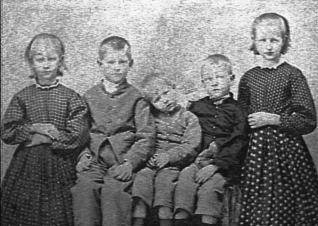Very few items of modern clothing are acceptable
for a proper impression for children with perhaps the exception of shoes
and socks. The following are to be used only as guides and it is hoped
that members with children will continue to research children's wear and
make appropriate changes as the children age.
INFANTS: Both girls and boys frequently wore long
gowns in white or white with small print. Necklines were usually wide
and sleeves short. A napkin or diaper was a soft cotton shaped
triangle. A diaper cover can be used to hide a modern disposable
diaper. Footware consisted of knitted booties or soft leather shoes. A
knitted sweater can be used for warmth when needed.
TODDLERS: Hair was parted in the middle for
girls, on the side for boys. Tunics were worn without gender
distinction. Growth tucks were common to extend the usefulness of the
garment. Boys outfits were generally more simple than that of girls.
Drawers generally came to below the knee and were of white cotton.
Socks came to over the knee. Parents may put their children in shoes
which will promote proper walking and development of the feet - black if
possible.
The following sources offer patterns or clothing
for children which are historically accurate:
YOUNG CHILDREN: Boys clothing surpasses the tunic
stage by age 5 or 6, and they begin to wear knee-length britches with
the tunics. As they aged the tops became shorter and shorter. Pants
for older children were not the short "Buster Brown" style from the turn
of the century. A sack coat could be worn for warmth and a loose shirt
or blouse might have been buttoned to the pants. Sleeves dropped off
the shoulder with a cuff. A simple ankle boot with square or round toe
and laces may be worn, black if possible.
For girls at this age hair was always parted in
the middle and length varied somewhat. Bodices had wider necklines than
that of women and long or short sleeves which dropped from the
shoulders. Petticoats were added. Skirt lengths varied from
knee-length to mid-calf length and were gathered or pleated and attached
to the bodice. A young girl could wear a simple round or square toe
ankle boot with laces, black is preferred.
TEEN-AGERS: A teen-age boy's clothing varied
little from that of a gentleman of the times. Girls wore bodice and
skirts attached similar to those of their mothers, but necklines might
still be wider than for an adult and short sleeves were still acceptable
although by the late teen years these would give way to long sleeves. A
White collar might be worn with the bodice. A Zouave jacket might be
added for warmth. A teen might consider a skirt, Garibaldi style blouse
with a Swiss waist or a Zouave jacket. Belts were popular with young
women. By the mid to late teens hair was worn up in a style similar to
an adult. Teens were more likely to wear hats than older women.
TOYS: Please avoid all modern toys. Ask your
mentor for suggestions for period correct toys. Proper period toys
might include wooden blocks, wooden guns or swords, books with
period-look bindings, rag dolls dressed in suitable attire, stuffed
rabbits or similar "dolls", wooden games, wooden pick-up sticks, wooden
checkers (draughts), period-look chess sets, dominos, etc. Some folk
toys are acceptable such as limberjacks, tops, etc. Period parlour
games are available which may be played by older children. The
Boys' Own Book or
The Girls' Own Book
are available in reprint and offer a wealth of ideas for the
entertainment of young people.
Michael and Virginia Mescher offer suitable toys for youngsters in their
Ragged Soldier Sutlery. These may be ordered from them at: mmescher@mail.erols.com.
Michael will enjoy sharing information with you regarding period toys
and games. Virginia
carries books and several items for use in camp. They can e-mail you a
catalog if you request one.


